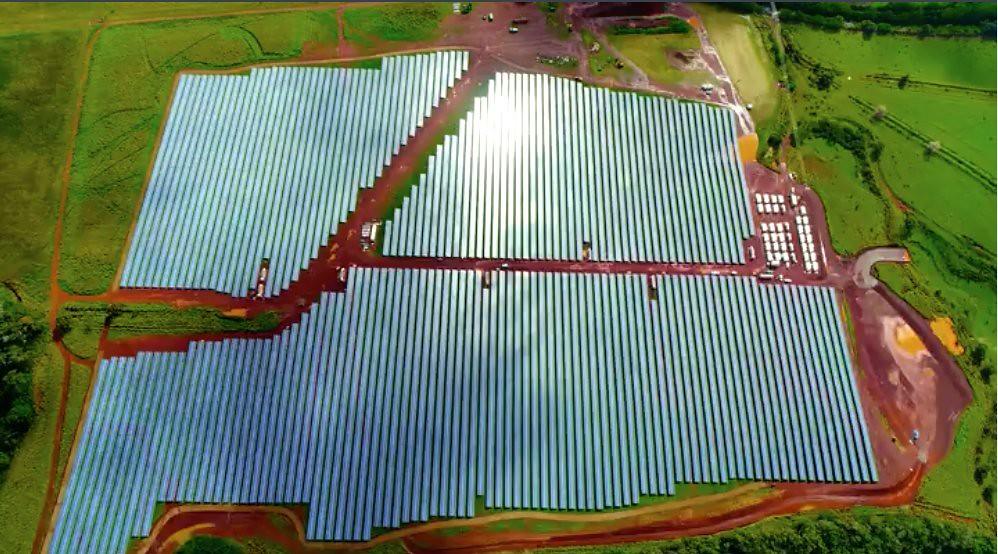夏威夷第一個公用事業規模、能蓄電的太陽能電廠在可愛島正式營運。這座電廠將太陽能儲存在特斯拉的高容量巨型電池中,讓居民在天黑後也有太陽能可以用。
這座可愛島公用事業合作社委託、特斯拉公司持有的電廠,位於利胡埃北邊一塊50英畝的土地上。
特斯拉創辦人暨技術長史陶柏(J.B. Straubel)在啟用典禮上表示,這是一個能讓社區使用100%再生能源的未來計畫,「這是太陽能首次可以24小時供電,並滿足公用事業的需求。」

可愛島公用事業合作社以特斯拉的Powerpack鋰離子電池存儲系統增加太陽能容量。每個Powerpack可以儲存52MW電力。
整個太陽能儲存系統提供最多13MW的電力到可愛島的電網,可滿足4500戶家庭的夜間用電高峰。在這座系統興建之前,可愛島的太陽能發電量已經達到電網所能處理的上限。
可愛島公用事業合作社總裁兼執行長畢索(David Bissell)說:「這個計畫對於合作社成員來說非常重要。夜間使用儲存的太陽能電力,能顯著減少燃料輸入需求和溫室氣體排放量。」
特斯拉將分階段啟用這個太陽能系統。
畢索估計,這座電力設備將取代可愛島公用事業合作社每年進口的160萬加侖柴油,也將讓合作社的再生能源電力比例超過40%。
此外,這座電廠的合約期為20年,合作社以每度13.9分的價格向特斯拉買電,比目前的石油價格便宜。
特斯拉去年11月併購太陽能電池廠SolarCity後正式進軍太陽能事業。除了可愛島,特斯拉也供應美屬薩摩亞塔屋島幾乎全島的太陽能和Powerpack鋰離子電池。
Hawaii’s first utility-scale solar farm that stores solar energy in giant battery packs and delivers it to homes after sunset has opened on the island of Kauai.
The solar power array enables a Kauai utility to increase its renewable energy generation to more than 40 percent due to high-capacity Tesla storage batteries.
The project, commissioned by Kauaʻi Island Utility Cooperative and owned by Tesla, Inc., is located on 50 acres of land north of Lihue.
The Kauai Island Utility Cooperative increased its solar capacity by connecting Tesla lithium-ion battery storage systems called Powerpacks to the solar farm. Each Powerpack can store 52 megawatts of power.
The solar storage system will feed up to 13 megawatts of electricity into Kauai’s grid to meet peak demand in the evening hours.
The Powerpacks store enough energy to service 4,500 homes during peak night demand. Before this system was built, Kauai’s grid had reached the maximum amount of solar power it could handle.
“The importance of this project for the member-owners of KIUC can’t be overstated,” said the coop’s president and chief executive David Bissell. “By using solar energy stored in the battery after the sun goes down, we will reduce our use of imported fuels and our greenhouse gas emissions significantly.”
Tesla’s chief technical officer and co-founder J.B. Straubel attended the blessing event. He remarked that this is a “future” project that enables communities to reach 100 percent renewable energy.
“For the first time, solar power can deliver 24 hours a day and follow the load when it is needed by the utility,” Straubel said.
Tesla will turn on the massive solar system in phases.
Bissell estimates that the project will displace the use of 1.6 million gallons of diesel annually for the Kauaʻi Island Utility Cooperative, and will bring the cooperative to more than 40 percent renewable generation.
He said the project also makes financial sense for KIUC. Under the terms of the 20-year contract, KIUC will pay Tesla 13.9 cents per kilowatt hour, which is less than the current cost of oil.
Tesla is diving into solar energy following its acquisition of SolarCity last November. The company also is powering nearly the entire island of Ta’u in American Samoa with solar power and its Powerpacks.
※ 全文及圖片詳見:ENS







